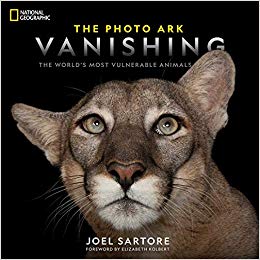
About National Geographic The Photo Ark Vanishing: The World's Most Vulnerable Animals
• Hardcover: 400 pages
• Publisher: National Geographic (September 10, 2019)
Celebrated National Geographic photojournalist Joel Sartore continues his Photo Ark quest, photographing species around the world that are escaping extinction thanks to human efforts.
Joel Sartore's quest to photograph all the animal species under human care celebrates its 15th year with this glorious and heartwrenching collection of photographs. The animals featured in these pages are either destined for extinction or already extinct in the wild but still alive today, thanks to dedication of a heroic group committed to their continued survival. From the majestic Sumatran rhinoceros to the tiny Salt Creek tiger beetle, Sartore's photographs bring us eye to eye with the kaleidoscopic diversity of shapes, colors, personalities, and attitudes of the animal world.
In these vivid pages, Sartore singles out the species most likely to disappear in the next decades, as well as some that have already been lost. Alongside these indelible images are the words of scientists and conservationists who are working to protect and restore populations of endangered species. With Sartore's distinctive portrait photography, he invites us to look closer--and to care more.
Review:
The Photo Ark: Vanishing is a stunning photo collection that shares portraits of the most endangered animals in the world, some who might even be the last of their kind. These amazing images stand out, Joel Sartore has captured the soul of each animal on a simple black or white background, forcing the reader to look into the eyes of many of the animals that our actions are helping to decimate.
From the foreword, where Elizabeth Kolbert states that E.O. Wilson has dubbed this era the Eremozoic, the age of lonliness, I knew that this would be a difficult book to look at. Joel Sartore's introduction, where he recalls photographing Nabire, one of the last northern white rhinoceros' and then later visiting her body, echoes this sentiment. The biodiversity of Earth's fauna graces the pages: snails, corals, fish, frog, lizard, deer, tigers and the chimpanzee's that share 99% of our DNA, showing that the environmental impact of human actions does not discriminate. A few lines of text accompany each photo and state the animal name, classification level through the International Union of Conservation, the amount of the species that are left and what actions have led to their decrease. These few lines serve as a powerful reminder of how small actions we complete everyday impact other animals. Beautifully done, this book will spark viewers into action to save the animals that grace the pages.
This book was received for free in return for an honest review.
Social Media
Please use the hashtag #thephotoarkvanishing and tag @tlcbooktours.
Purchase Links
Amazon | Amazon.ca | IndieBound | Barnes & Noble
About the Authors
JOEL SARTORE is a photographer, author, and 30-year contributor to National Geographic magazine, named 2018 National Geographic Explorer of the Year. Through his National Geographic Photo Ark project, he plans to photograph every species of animal under human care, an estimated 12,000. (As of Nov 2018, he has photographed nearly 9,000.) A three-part PBS/Nova special, "Rare," featured his project in 2017. His "Fundamentals of Photography" is the best-selling offering of all The Great Courses, and he is a frequent guest on CBS Sunday Morning.
ELIZABETH KOLBERT (foreword) is a staff writer for The New Yorker. Her most recent book, The Sixth Extinction, received the Pulitzer Price for general nonfiction in 2015. She is also the author of Field Notes from a Catastrophe: Man, Nature, and Climate Change. A two-time National Magazine Award winner, Kolbert is a visiting fellow at the Center for Environmental Studies at Williams College.






















 RSS Feed
RSS Feed



